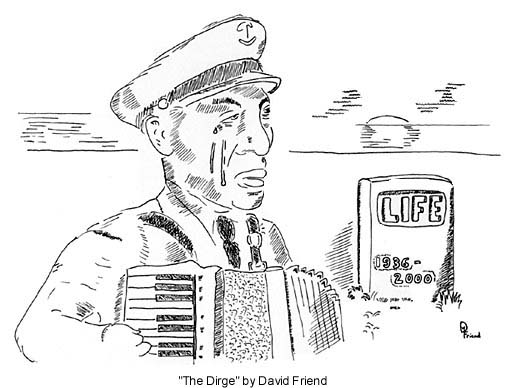Last month, Time Inc. announced that it was suspending publication of the weekly Life magazine. Like some charmed and perpetually resuscitated being in a mystical Eastern rebirth cycle, the publication seems destined to occupy a limbo of near-death experiences and "eventual resurrection" rumors.
For some time now, media observers have been keeping a death watch over the latest incarnation of
Life magazine, a pamphlet-sized shadow of its former self that for the last three years had been distributed as a color supplement in newspapers. The original
Life, the pioneering American picture magazine, was founded as a weekly in 1936, and was considered one of the great triumphs in publishing history (reaching some 8 million readers in its heyday). It introduced photo essays to the culture; nurtured the careers of dozens of giants of photojournalism; took pre-war readers to the ends of the earth; covered revolution and the Spanish Civil War, World War II and Korea; chronicled the rise of Communist China and the Cold War, the atomic bomb and the space program; served as the platform upon which publisher Henry Luce formulated his notion of "The American Century"; gave the world its first glimpse of everything from President Kennedy's assassination to the miracle of birth, from tips on "How To Undress in Front of Your Husband" to the refurbished behemoths of Abu Simbel; explored the heartland with relish and Hollywood with wide-eyed affection; contributed to helping mobilize U.S. sentiment against the Vietnam War (through its seminal story "One Week's Dead"); and changed the face of journalism. It suspended publication in 1972--done in by the high cost of printing and postage, staggering overhead, and the migration of advertising to television.
Upon its relaunch in 1978, as a monthly,
Life continued as a vehicle for quality photography--and for the lost art of picture storytelling. I worked at the monthly
Life for 19 years, finishing my tenure there as director of photography. After the magazine folded yet again in 2000 (I drew the above cartoon
that year for
The Digital Journalist), the magazine went into
hibernation, only to be recast and retooled in 2004 and rolled out as a
feeble weekly, intended to be doled out by newspapers.
When a living, breathing Mark Twain heard that his obituary had appeared, prematurely, in a London paper, he famously wired a message to the publisher: "The reports of my death are greatly exaggerated."
When I heard the news last month that Life had finally died, I wondered, wistfully, "Really? How could anyone tell?"


